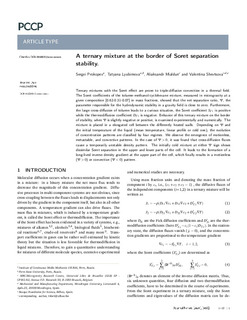Title
A ternary mixture at the border of Soret separation stabilityPublication Date
2021Other institutions
IkerbasqueInstitute of Continuous Media Mechanics UB RAS
Perm State University (Russia)
Université Libre de Bruxelles
Version
PostprintDocument type
Journal ArticleJournal ArticleLanguage
EnglishRights
© 2021 Royal Society of ChemistryAccess
Open accessPublisher’s version
https://doi.org/10.1039/D0CP06471HPublished at
Physical Chemistry Chemical Physics Vol. 23. N. 14.Publisher
Royal Society of ChemistryUNESCO Classification
ThermodynamicsAbstract
Ternary mixtures with the Soret effect are prone to triple-diffusive convection in a thermal field. The Soret coefficients of the toluene–methanol–cyclohexane mixture, measured in microgravity at a gi ... [+]
Ternary mixtures with the Soret effect are prone to triple-diffusive convection in a thermal field. The Soret coefficients of the toluene–methanol–cyclohexane mixture, measured in microgravity at a given composition [0.62–0.31–0.07] in mass fractions, showed that the net separation ratio, Ψ, the parameter responsible for the hydrodynamic stability in a gravity field is close to zero. Furthermore, the large cross-diffusion of toluene leads to a curious situation: the Soret coefficient ST1 is positive while the thermodiffusion coefficient DT1 is negative. The behavior of this ternary mixture on the border of stability, when Ψ is slightly negative or positive, is examined experimentally and numerically. The mixture is placed in an elongated cell between the differently heated walls. Depending on Ψ and the initial temperature of the liquid (mean temperature, linear profile or cold one), the evolution of concentration patterns are classified by four regimes. We observe the emergence of motionless, metastable, and convective patterns. In the case of Ψ > 0, it was found that cross-diffusion fluxes cause a temporarily unstable density pattern. The initially cold mixture at either Ψ sign shows dissimilar Soret separation in the upper and lower parts of the cell. It leads to the formation of a long-lived inverse density gradient at the upper part of the cell, which finally results in a motionless (Ψ > 0) or convective (Ψ < 0) pattern. [-]
Collections
- Articles - Engineering [761]





















